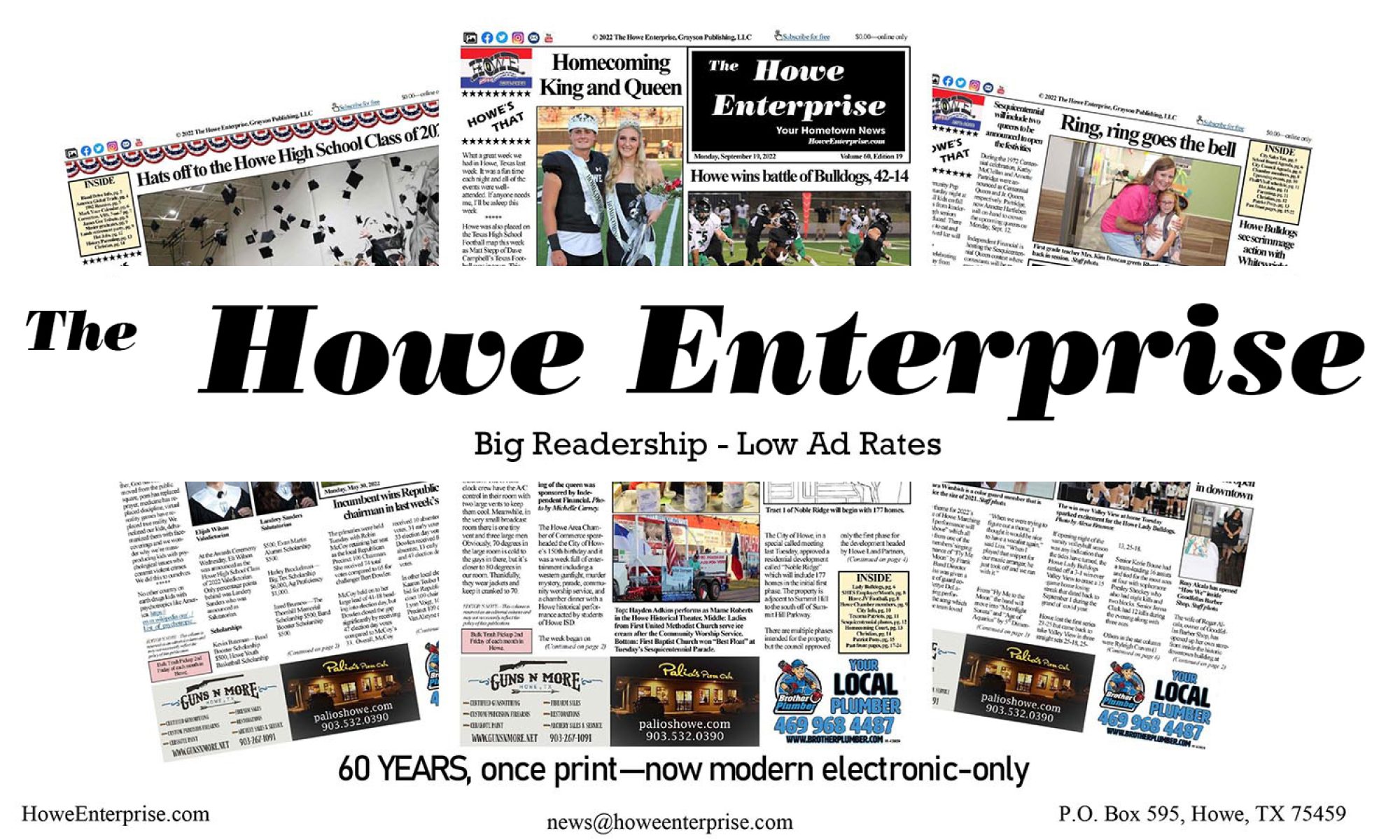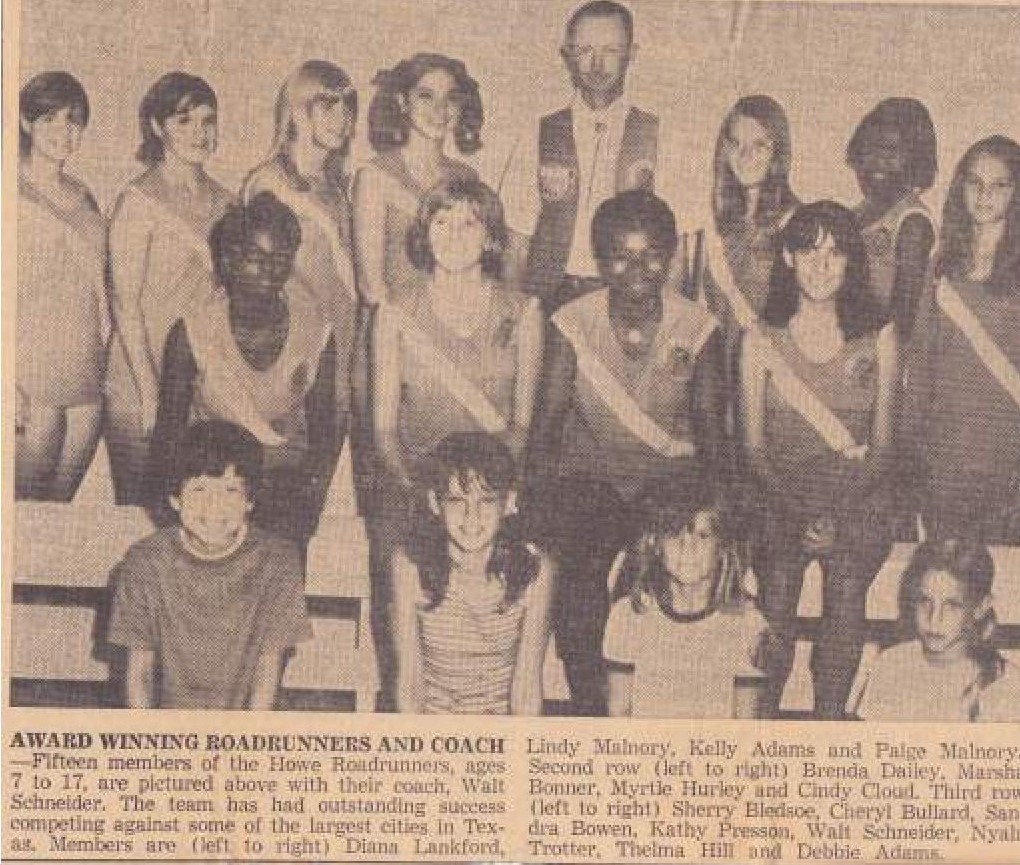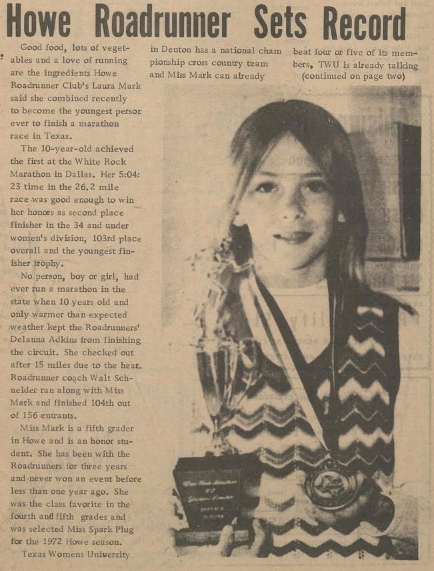From the Howe Enterprise vault: Originally published November 24, 2014, in Volume 52.07
In a plot for a Hollywood movie, Walt Schneider started a girls track program in Howe in 1965 and for seven years, took a bunch of small town girls with no experience and trained them to compete with the highly trained athletes all over Texas and even Ohio. When it was all over in 1972, those girls had more ribbons and medals than any program around.
Schnieder was born Dec. 20, 1920, in New Mexico, He and his parents moved to Howe in 1935 and he graduated from Howe High School in 1938. After high school, he worked on a farm before joining the Civilian Conservation Corps.
“That was the best thing that ever happened to me,” said Schneider. “There were no jobs available and no money available. Franklin Roosevelt had built these camps under the Army Administration. They sent me to Phoenix, Arizona and we fenced and surveyed all of that land out in Arizona. I got more education there than I think I did in high school. I also got more training in the CC Camp than I did in the military.”
While in Phoenix, Schneider began to work on the library in his spare time by doing construction work on the facility and painting the Celotex walls white and that laid the foundation for his life in the construction industry.
Schneider joined the US Navy in May of 1942 during World War II. He worked on defense projects in Fort Huachuca where they built the first black military post for 6,000 recruits. While in the Navy, he spent 33 months overseas. Eight months were in American Samoa before being on the USS President Polk.
“We made six landings including the last one, Iwo Jima,” said Schneider. “The invasion was planned on our ship by General Cates.”
After his service in the US Navy, Schneider went to business with a guy he met while in the CC Camp. And later got into the construction business in Phoenix.
In 1950, he came to back Howe to help his dad put in a Grade A dairy. He constructed a barn for him, but his father developed cancer and died in 1956. Walt Schneider bought the farm in the Bennett Road and Schneider Road area. He later developed the land by building 13 homes. He moved four military barracks that were 2,500 square feet and bricked them and changed the entire structure and made homes from them. He helped out his family by making contractors out of six nephews that helped him construct homes.
Schneider’s hobby as a track coach began when his nine-year-old adopted daughter, Elaine, wanted to enter track meets. He entered her against boys since there was not a track team for girls in this area.
“At the football field (Bulldog Stadium), at 10 years old, she was so far ahead of the rest of the girls that she’d come home and cry because they didn’t have girls track,” Schneider remembered. “I asked her if she wanted to compete with the boys and she did. She beat them all except for two of them on the football team. Eventually, she began to run in girls meets and she went to the regional meet in Fort Worth at Perrington Field and won the 60, 100 and 220-yard dash events as well as qualified in the high jump to go to state.
With Elaine’s success, Walt Schneider started to earn a reputation as someone who knew how to coach a girl in track. In 1965, he would have an opportunity that would change his life and a lot of young girls lives. That year a young raw farm girl with athletic ability was introduced to Schneider.
“Somebody told me that Carlene Wilson was fast so we went and got her,” said Schneider. “I told her to bring you a sidekick because we don’t like to take one girl by themselves. So she took Marsha Bonner.”
Wilson, a fierce competitor, had no training other than racing her neighbor Rick Orr every day while playing. In Sherman, in her and Bonner’s first track meet, they set records against big-school trained competitors.
“When we ran at the Sherman Jaycees as 12-year-olds, we had to run against high school girls. And we won.” said Wilson (now Carlene Walker).
Schneider worked with both Wilson and Bonner extensively and trained them to compete. Wilson, however, was not comfortable using starting blocks and it made her nervous. Schneider didn’t push the issue and let her run in meets from a standing start. The starting blocks became no advantage to the competition. Wilson’s natural speed earned a barrage of blue ribbons.
“They were just little country girls that got put up against big-school kids. Carlene and Marsha both won in the Sherman Jaycees meet, so they sent us to Abilene.” Schneider said. “They were so scared. Carlene, I think, was too nervous to really perform, but Marsha got second place in the high jump that year and that started her up.”
Bonner began to take off as a track star in numerous events such as the 220, 440 and high jump and would often come away a winner in all events. She would later qualify to go to California at a tri-state event with Louisianna, Texas and Mississippi.
“Carlene was a jackrabbit.” said Bonner. “Her stride was so incredibly long; way longer than mine and I had longer legs. She would leave marks in the track when she ran because it was like she hopped.”
Bonner and Wilson, who later went to state in high school, became the duo that would kick-start a run of unthinkable success from a small town and it was Walt Schneider’s lovable encouraging way of coaching that made girls want to compete for him.
“He was an awesome coach.” Said Walker. “He taught me how to believe in myself. I’d been involved in team sports, but when it came down to an individual basis, he taught me how to believe in myself. Everything was positive and upbeat I don’t know if I ever heard him say a negative word. His reinforcement would be to tell you that you ran a good race, but you’ve got more in the tank.”
Bonner also expressed her sentiments for Schneider, “I love that man.” said Bonner. “There are not enough words in the human language that could tell the story of this man and his kindness, love, and passion for girls sports.”
It was that infectious love and passion that created the seven-year story of The Roadrunners. And one thing that has yet to be mentioned is that he did it all for free. He paid for everything and did it all on his own. He was a complete volunteer from the true essence of the word. He did it all because he loved it all.
“I coached the Howe High School kids and we tried to get a relay team.” said Schneider. “One day we were there and six junior high girls come up to me and asked if they could go out for track. I told them that the schools don’t have any track meets. I told them that we just compete in the summertime versus Dallas and places like that. That summer, I ended up with 26 girls and that was the “runningest” bunch of kids I ever seen.”
He took them to Bulldog Stadium and turned them loose to run and race and the girls began to fuss and fight about who won. Schneider quickly addressed the situation and told them that he was glad that all of them were good.
“I told them that we’d find a place for all of you.” said Schneider. “We had some of the greatest kids. Kathy McClellan was the fastest one in the 100-yard dash, Sheri Bledsoe was second. She asked me how can she become first. I told her to lose five pounds and work at it. Kathy went off to a vacation for two weeks and came back for a Sherman meet and Sheri beat her. That disturbed Kathy terribly. I told her that you can’t miss two weeks of training. Someone is going to come along and beat you.”
Garland, a 5A school, invited Howe to their meet. Out of the 11 blue ribbons available, Howe won eight of them. Schneider said that the Garland officials couldn’t believe that these scrappers from tiny Howe could beat their state champion-level athletes.
In a two-year period from 1969 to 1970, Schneider’s girls won 34 medals, which were awarded to the top three placed in regional, state and tri-state meets of AAU, AAF and JC State meets. In those two years, his girls took first place in the Dallas AAU twice, the Plano AAF, Richardson AAF and the Abilene LAAF State meet.
In 1970, the Sherman Democrat ran a story on Schneider and his success with his group of country small town athletes. The story was a tribute to the unofficial, unpaid track coach for a group of girl athletes who thought he was great. In that article, one of Howe’s finest athletes of all time, Billy Bryant Cloud, said, “He is a man with a big heart. Not many adults will take the time he does to help a group of girls.”
A 13-year-old Debbie Adams said, “It is real hard to put in words how I feel about my coach. He must care an awful lot about us to spend his time and money. He would do anything he could for anyone who likes and wants to be a track athlete. I think he is a great man.”
Of that special 1970 group were Diane Lankford, Linda Malnory, Sue Knight, Nyla Trotter, Cindy Cloud, Marsha Bonner, Brenda Dailey, Thelma Hill, Theresa Knight, Sheri Bledsoe, Sheryl Bullard, Debbie Adams, Kelly Adams, Sandra Bowen, and Kathy Presson.
In those days, the boys got trophies and the girls got ribbons. Schneider quoted in that story said, “I hope that in the near future that this unfair practice will be changed.”
Because of his own personal feelings on the matter, he bought trophies (with his own money) and presented them to the girls at a dinner honoring them for their accomplishments.
But, the main story of this article on this wonderful man may be that the only color he cared about were the color of the ribbons. In the 1969 and 1970, Schneider coached three African-American girls (Myrtle Hailey, Thelma Hill and Brenda Bailey) from Trenton and they ran as representatives from Howe. There was a time when Howe was different than it is today. And at that time, it took an exceptional human being to see through the hate that existed amongst the previous generations all over the south.
“We would take any girl that could compete and those girls were exceptional,” said Schneider. “Our girls loved them and they became the best of friends. It was just like I told Carlene years before. Myrtle was the best athlete we had heard about and I told her to bring a friend because we wanted her to have someone to make her comfortable. That’s when we ended up with Brenda too. They were exceptional in every way.”
Marsha Bonner recalls that the people of Howe became so familiar with the Trenton runners, that when Trenton came to Howe to play basketball, Myrtle Hailey was given an ovation from the Howe crowd.
Schneider often took the 13 girls to track meets in his ’65 Mustang. Once a man said he was going to turn them in. The girls began to say that they were all related sisters and cousins Myrtle and Brenda told the man that they were adopted.
In the final year of the Roadrunners, Schneider ended up taking two girls to Canton, Ohio. Laura Mark and Sue Knight became two dynamic athletes to finish up the program just as Wilson and Bonner had started it in the beginning. His niece, Laura Schneider ran with him at the age of 7 and she eventually became known as the fastest girl since Wilson.
To make this “could be made for Hollywood” story even more outrageous is the fact that as young boy, Schneider had polio and was told he’d never be able to run. He had read about a boy who went through an operation and later competed in a marathon. That became Schneider’s goals and he achieved that goal.
Walt Schneider spent a segment of his life trying to help his girls earn ribbons, medals and trophies. Those honors are buried in closets, but the love from and for that man is etched in far more valuable place. He will be remembered as one of the finest men to ever call Howe home.







